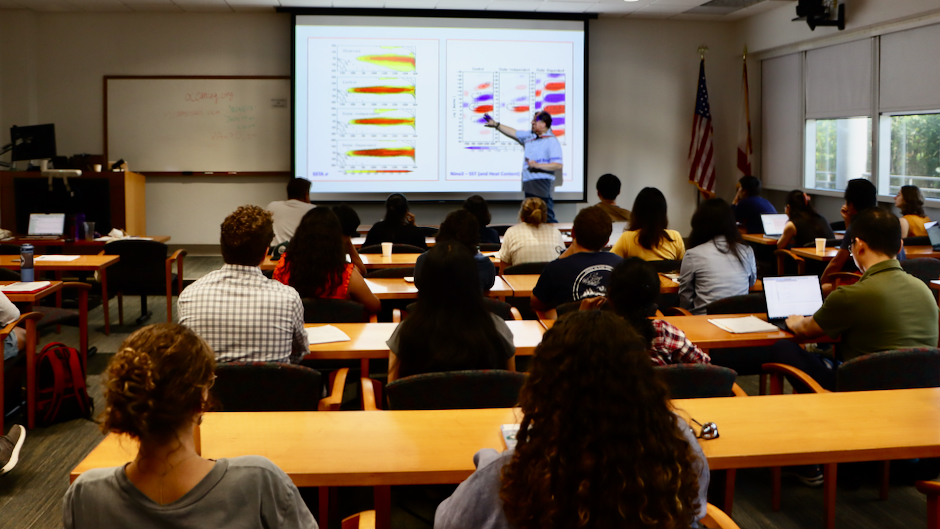Graduate students and scientists specializing in oceanographic, climate, and statistical sciences gathered for a weeklong summer school program designed to teach best practices for understanding, deriving, and communicating the uncertainties involved in gathering and analyzing ocean and climate data.
Hosted by the University of Miami Rosenstiel School of Marine, Atmospheric, and Earth Science, the five-day session covered topics related to the fundamental nature of ocean data, the specialized statistical tools for analyzing the data, and the uncertainties in ocean and climate predictions.
Through a combination of lectures, hands-on computer-based tutorials, and social events, the program brought together a diverse group of students and fostered a collaborative and engaging learning environment on a topic that is not generally taught in graduate schools.
The Working Group on Ocean Uncertainty Quantification at the US Climate Variability and Predictability Program (US CLIVAR) organized the weeklong session.
During the program, students attended lectures and science talks by members of the Working Group, Rosenstiel School professors of ocean and atmospheric sciences, Carnegie Mellon University, Imperial College London, the University of Colorado, the University of Texas at Austin and the National Aeronautics and Space Administration (NASA).
In any scientific field, a key protocol for researchers is not to eliminate uncertainty in data but to better quantify and clearly communicate its size, nature, and degree of uncertainty. For example, when an ocean scientist captures data measurements in the field, locations where the data was captured can be off by a few kilometers, or the tools used to collect the data could be slightly out of calibration.
For example, imagine a security time-lapse camera recording an event for only five seconds every ten minutes within an hour. In reality, one would have only 30 seconds of footage from the hour. The recorded playback would not be an accurate representation of what occurred during the hour, thereby creating uncertainty of what actually happened during those 60 minutes. According to the members of the Working Group, uncertainty is a constant factor of any type of data collection for research, therefore quantifying uncertainty is necessary to evaluate the confidence one can have in the data.
“Our Working Group members, like many other scientists, argue that ocean data are not useful to scientists or other stakeholders if that data are not accompanied by estimates of how uncertain they are,” said Shane Elipot, a research associate professor in the Rosenstiel School’s Department of Ocean Sciences and co-chair of the Ocean Uncertainty Quantification Working Group. “Quantifying and communicating such uncertainties is crucial to fully understand data and its implications, especially as it relates to climate change. Uncertainty estimates make the data complete.”
The afternoon sessions featured a series of computer-based group activities that allowed students to explore real ocean data and familiarize themselves with best practices for quantifying their own data. The University of Miami Frost Institute for Data Science and Computing provided the Python computing environment for students to practice hands-on activities.
“Over 145 students from around the world applied, and only 29 were selected to attend,” said Elipot. “This is a very unique opportunity for the next generation of scientists in our fields to hear from and interact with the experts currently working on ocean and climate data uncertainties and their impacts on climate assessments and predictions.”
Paloma Cartwright, a graduate student in the Rosenstiel School’s Department of Ocean Sciences, is studying how sea level rise impacts the coastlines of Florida and the Bahamas. Using her background in data science, she hopes to advance climate change adaptation solutions for the Bahamas, where she was born and still resides.
“This program underscored the importance of quantifying uncertainties in ocean data,” Cartwright said. “We were introduced to scientists who conduct this type of leading-edge research, and we learned about the various tools available that we can use when working on our own data to communicate findings appropriately.”

